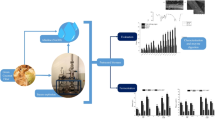Abstract
This research examined several enzymatic and microbial process for the conversion of waste cellulosic fibers into ethanol. The first was a one-stage process in which pulp fines were contacted with commercial enzyme solutions. The second process used sequential, multistage saccharification. The third used sequential enzyme addition in a countercurrent mode. Experiments compared the results with various feed stocks, different commercial enzymes, supplementation with β-glucosidase, and saccharification combined with fermentation. The highest saccharification (65%) from a 4% consistency pulp and the highest sugar concentration (5.4%) from an 8% consistency pulp were attained when 5 FPU/g plus 10 IU/g of β-glucosidase were used. Sequential addition of enzyme to the pulp in small aliquots produced a higher overall sugar yield/U enzyme than the addition of the same total amount of enzyme in a singledose. In the saccharification and fermentation experiments, we produced 2.12% ethanol from a 5.4% sugar solution. This represents 78% of the theoretical maximum. This yield could probably be increased through optimization of the fermentation step. Even when little saccharification occurred, the enzyme facilitated separation of water, fiber, and ash, so cellulase treatment could be an effective means for dewatering pulp sludges.
Similar content being viewed by others
References
McGovern, J. N., Berbee, J. G., Bockhelm, J. G., and Baker, A. J. (1983), Tappi. J. 66(3), 115–118.
Joyce, T. W., Webb, A. A. and Dugal, H. S. (1979), Tappi. J. 62(4), 83–84.
Diehn, K. and Zuercher, B. (1990), Tappi. J. 73(4), 81–86.
Walkinshaw, J. W., Sladek, K. J., and Eberiel, D. T., (1984), Tappi. J. 67(10), 104–105.
Wayman, M., Chen, S., and Doan, K. (1992), Proc. Biochem. 27, 239–245.
Jeffries, T. W., Yang, V., and Davies, M. (1998), Appl. Biochem. Biotechnol. 70/72, 257–265.
Miller, G. L. (1959), Anal. Chem. 31, 426–429.
Jeffries, T. W. (1985), in Energy Applications of Biomass, Lowenstein, M. Z., ed., Elsevier, London and New York, pp. 231–251.
Author information
Authors and Affiliations
Corresponding author
Rights and permissions
About this article
Cite this article
Jeffries, T.W., Schartman, R. Bioconversion of secondary fiber fines to ethanol using counter-current enzymatic saccharification and Co-fermentation. Appl Biochem Biotechnol 78, 435–444 (1999). https://doi.org/10.1385/ABAB:78:1-3:435
Issue Date:
DOI: https://doi.org/10.1385/ABAB:78:1-3:435




